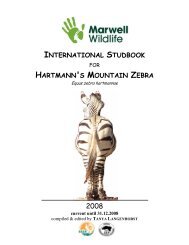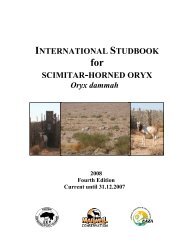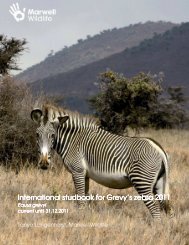KS3 Adaptation Resource Pack - Marwell Wildlife
KS3 Adaptation Resource Pack - Marwell Wildlife
KS3 Adaptation Resource Pack - Marwell Wildlife
You also want an ePaper? Increase the reach of your titles
YUMPU automatically turns print PDFs into web optimized ePapers that Google loves.
Activity answers<br />
<strong>Adaptation</strong> trail<br />
1. Humboldt penguin<br />
Habitat: Rocky coasts and cool waters<br />
Wings: Act as flippers to help them swim<br />
Other adaptations: Beak has small teeth to keep hold of fish; waterproof feathers; streamlined body<br />
to move quickly through water; black and white camouflage so can’t be easily seen by predators<br />
2. Cheetah<br />
Habitat: Desert, grasslands, bushveld, mountainous areas<br />
Pattern useful for: Camouflage – helps them to hide from their prey in savanna grasses<br />
Teeth: Big teeth – sharp canines, strong incisors – used for catching and eating their prey<br />
Skull: Smaller than leopard/lion skull – helps cheetah to be streamlined for running at speed<br />
Other adaptations: Long, slim legs for running fast; Long flat tail that allows it to change direction<br />
when chasing its prey at speed<br />
3. Crested porcupine<br />
Habitats: Many habitats from forest to desert<br />
Obvious adaptation: Quills<br />
Helps it survive by: Defence against predators, can shake them to make them rattle or run at<br />
attacker and stick quills into them<br />
4. Black and white colobus monkey<br />
Habitat: Rainforest<br />
<strong>Adaptation</strong>s: Long arms – for swinging between trees, moving along branches; Long tail – acts as a<br />
brake or used for balance<br />
5. Giraffe<br />
Habitat: Savanna or dry, open country and woodland<br />
<strong>Adaptation</strong>s to make it tall: Long legs; Long neck<br />
Why being tall is useful: Helps giraffe to reach food; Can look out for danger<br />
Long tongue: Useful for grabbing and picking leaves to eat<br />
6. Sand cat<br />
Habitat: Sandy desert<br />
How hot?: 58°C<br />
How cold?: -5°C or -25°C (winter)<br />
<strong>Adaptation</strong> to survive climate: Special solid, dense fur that insulates them<br />
Survival strategy: Digs burrows to get shade;<br />
<strong>Adaptation</strong> for this – Strong legs<br />
31
















